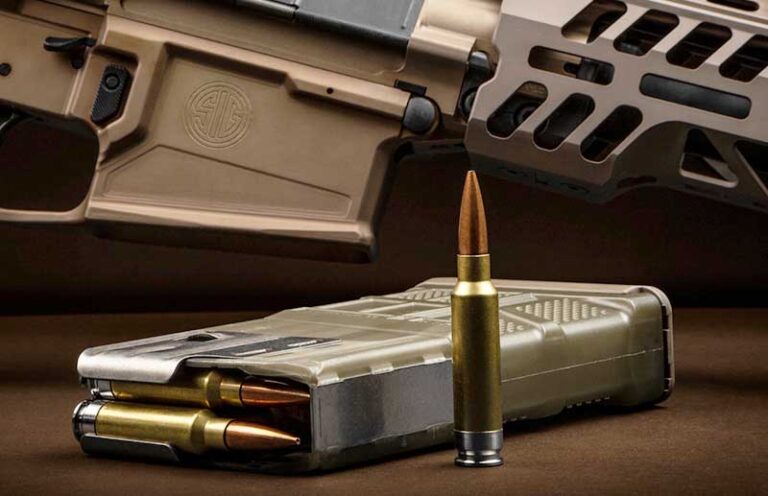
A closer look at the development, adoption and ballistics of .277 Fury, the U.S. Army’s newest cartridge.
The .277 Fury is a beast of a cartridge designed to shoot flatter and transfer more energy to its target at farther distances. The U.S. Army calls the round “next generation,” and based on .277 Fury’s capabilities, that is not an exaggeration.
Compared to the current-issue service cartridges it’s slated to replace like 5.56x45mm and 7.62x51mm, the .277 Fury offers greater energy, improved terminal ballistics and higher ballistic coefficient bullets that slip through the air with ease. It appears that America has settled on a new battle rifle cartridge to arm its troops, but just how much better is it?
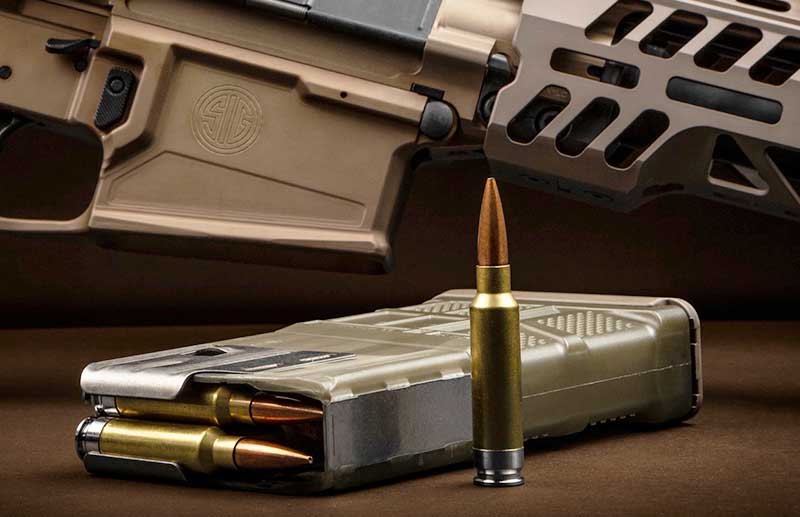
Why was the .277 Fury Developed?
The U.S. Military is always looking for an edge. In 2017, the Next Generation Squad Weapon (NGSW) program was launched by the U.S. Army with the goal of replacing the M4 carbine and M249 SAW light machine gun, both chambered in 5.56 NATO, as well as the M240 machine gun in 7.62 NATO.
These have served the military well—the 5.56 since 1963 and the 7.62 from way back in 1954. But warfare changes. The cartridges that our military currently uses are effective, but the 5.56, for example, has had known penetration issues in combat. Body armor has evolved to be lighter and tougher, and that means rifle cartridges need to evolve in tandem.
NGSW Program
For the new cartridge of the NGSW program, the Army specified that it wanted a 6.8mm or .277-caliber bullet. This has been a long-time desire and has resulted in aborted attempts at the caliber, such as the 6.8mm Remington SPC. For its latest effort, the Army had its own .277-caliber bullets designed by Picatinny Arsenal weighing 130 and 140 grains with velocity potentials of more than 3,100 feet per second.
Furthermore, firearms manufacturers were invited by the Army to submit cartridge and rifle designs for review, essentially integrated systems. For the rifle, the specifications dictated it could not be longer than 35 inches and could only weigh up to 12 pounds with accessories and optics. The weapon-cartridge system also needed to penetrate body armor out to 500 meters, hit targets out to 610 meters, and suppress targets out to 1,200 meters.
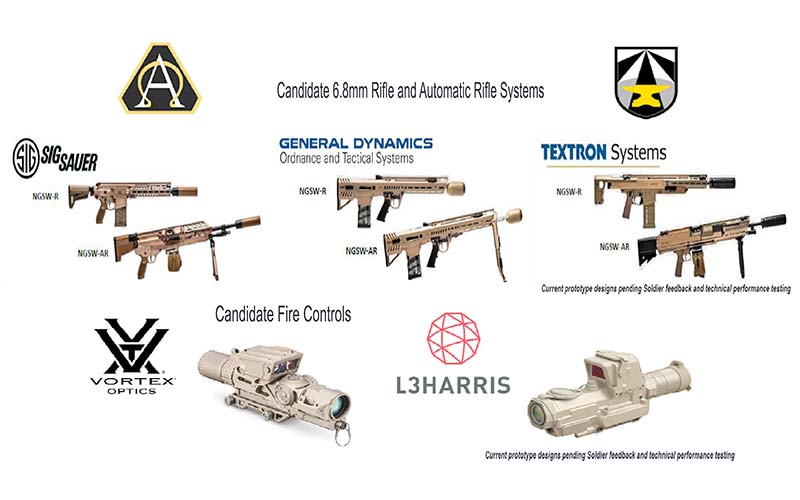
SIG's entry to the program was the 6.8×51mm Common Cartridge chambered in its XM5 rifle and XM250 LMG. SIG’s new cartridge has a maximum overall length of 2.83 inches, which means it will load and feed from any 7.62 NATO (.308 Winchester) detachable box magazine. Other submissions to the program included manufacturers such as General Dynamics and Textron Systems.
In 2020, SAAMI, the organization that creates standards for ammunition, approved the round as the .277 SIG Fury, which sounds a helluva lot sexier than 6.8×51mm. In 2022, the Army adopted the round alongside SIG’s rifle and LMG. Uncle Sam now not only has a new cartridge, but a couple of new guns to shoot it with.
Speed + Energy = Fury
So, why would the Army want a new 6.8mm cartridge? It already had 7.62, which is battle-proven, as well as 6.5 Creedmoor which is loved by long-range competitive shooters. The answer? The .277 has superior velocity and energy.
However, there was a tradeoff in this arms race, particularly relating to chamber pressure.
To achieve the Army’s desired ballistic properties, the chamber pressure of .277 Fury is a mind-blowing 80,000 PSI. By comparison, 5.56 NATO produces about 60,000 PSI and 7.62 NATO about 62,000 PSI. Other calibers used by the military don’t even come close to the pressure generated by the .277 Fury. The massive .50 BMG only produces about 53,000 PSI, and the .338 Lapua Magnum about 61,000 PSI. The 80,000 PSI generated by .277 Fury is a lot of pressure to contain in a cartridge case, and it’s why not just any rifle can handle it.
Case Study: .277 Fury
The extremely high chamber pressure of .277 Fury forced SIG to rethink traditional cartridge case design. Because brass alone is not enough to contain it, the company took the hybrid approach and designed a casing made of multiple types of metal.
To reinforce the .277 Fury, it uses a stainless steel base attached to a brass body via an aluminum locking washer. The base is much more robust and is strong enough to withstand the high pressure that would literally blow apart a traditional brass cartridge case.

Though, the Fury thankfully isn’t pigeonholed to this radical case design. The cartridge can be downloaded to 65,000 PSI which allows it to safely use conventional brass cases. But this raises the question, what is the benefit of a chamber pressure at 80,000 PSI with a 135-grain bullet traveling at 3,000 fps?
Quite simply, a flatter trajectory and more energy down range.
.277 Fury Ballistics
Compare the ballistics of .277 Fury to other military calibers like the 5.56 and 7.62 NATO and you soon see that the Fury has a distinct edge. When you pit the trajectory of .277 Fury against that of 5.56, 7.62, and 6.5 Creedmoor, you see that some bullets fall like stones.
According to SIG, the .277 Fury loaded with a 150-grain bullet has a muzzle velocity of 3,120 fps out of a 24-inch barrel. Compared to other currently used military cartridges, this is impressive. The common 149-grain M80 load of 7.62 from Lake City has an advertised muzzle velocity of 2,790 fps when fired from a 22-inch barrel. The 62-grain M855 load of 5.56 can achieve a muzzle velocity of 3,110 fps when fired from a 20-inch barrel, and 143-grain Hornady ELD-X 6.5 Creedmoor has an advertised muzzle velocity of 2,700 fps out of a 24-inch barrel. While that may not seem like that big of a difference for some of these, the trajectory table should speak for itself.
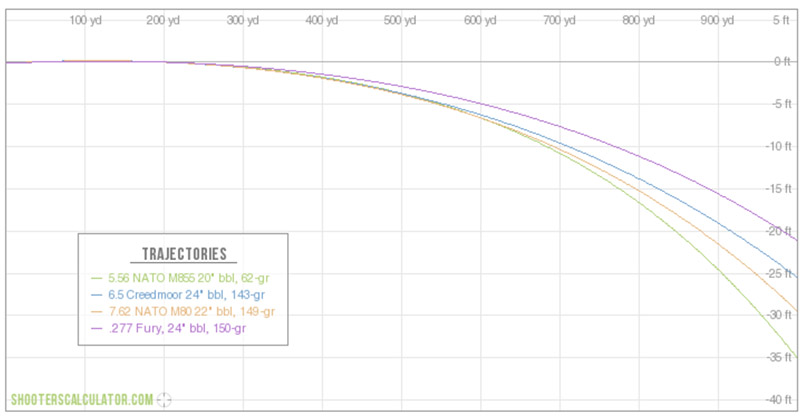
At 1,000 yards, the .277 Fury drops only 253.6 inches. On the other hand, the 6.5 Creedmoor drops about 306 inches, 5.56 NATO drops 421 inches and the 7.62 NATO drops 354 inches. Data doesn’t lie, and the Fury shoots much flatter than these other service cartridges. Comparably, it also delivers a beastly amount of energy.

There is a 33-percent difference in muzzle energy between the .277 Fury and the 6.5 Creedmoor, a 23-percent difference between it and the 7.62 NATO and a whopping 83.5-percent difference between the cartridge and the 5.56 NATO. Why is this important? Kinetic energy helps to better understand the cartridge’s terminal ballistics, particularly its potential to penetrate a target.
Fast and Fury-ous Ammo Options
Since the .277 Fury is so new, only SIG is currently producing commercially available ammo. SIG’s offerings include a long-ran
ge target load and two hunting loads. While two of these cartridges produce pressures low enough to be used with traditional brass casings, one of the hunting loads is juiced up enough to require the new hybrid case design. Note that while all these loads are expensive, they can typically be found for less than the listed MSRPs.
ELITE BALL FMJ 277 SIG FURY

This is the target load, and it uses a 135-grain FMJ bullet with a 0.475 BC. Factory data states that muzzle velocity from a 16-inch barrel is 2,750 fps and 3,000 fps from a 24-inch barrel. This round is specifically designed for long-range shooting. Expect to pay about $1.70 per round for this option, as 20-round boxes have an MSRP of about $34.
277 SIG FURY, 130gr, VENARI SOFT POINT HUNTING
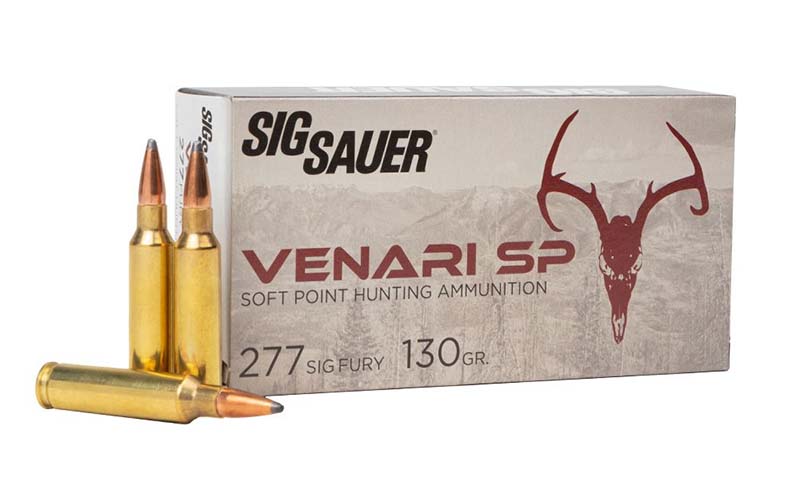
If you want to put meat on the table, SIG’s traditional 130-grain soft-point option offers an advertised muzzle velocity of 2,710 fps and muzzle energy of 2,120 foot-pounds. This round is designed for whitetail deer up to elk. With an MSRP of about $42 per 20-round box, each trigger pull will cost about $2.10.
ELITE BONDED POLYMER TIPPED 277 SIG FURY HYBRID
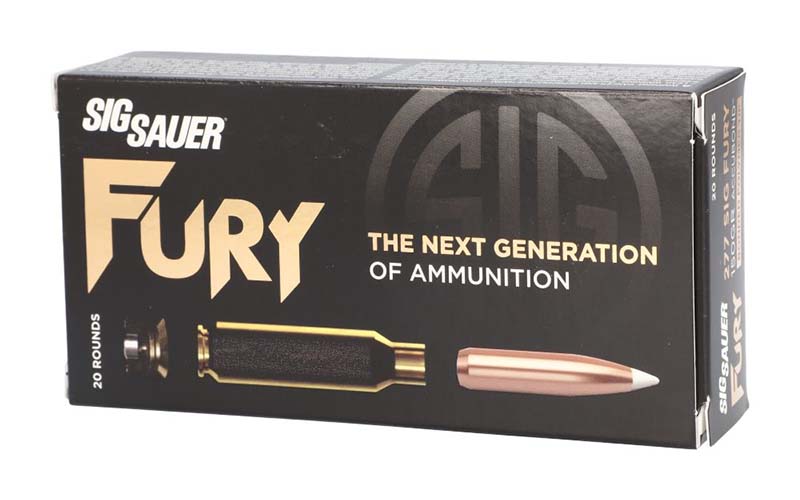
The hybrid cartridge load uses a 150-grain polymer-tipped, boat-tail Nosler Accubond bullet that offers military-grade horsepower for the hunt. Utilizing the stainless-steel base hybrid case, the round cranks out 3,120 fps muzzle velocity from a 24-inch barrel and produces around 3,243 foot-pounds of muzzle energy. This performance isn’t cheap since 20-round boxes have an MSRP of about $80, resulting in a cost of about $4 per shot.
.277 Fury Rifles
When the .277 Fury was introduced to the shooting public in 2019, the only rifle chambered in the caliber was the SIG Cross, a lightweight minimalist bolt-action hunting rifle that weighs 6.5 pounds naked without a scope.

SIG has since offered the MCX-Spear chambered in the cartridge as well, the company’s civilian version of the U.S. Army’s XM7 rifle. The semi-automatic rifle has similar features as an AR-15/AR-10 platform, but it uses a short-stroke piston in lieu of the direct gas impingement system found in typical ARs. Either of these rifles would do good work as a long-distance target rifle, but if I had my choice, I’d choose the lightweight bolt action, especially for hunting in rough terrain.
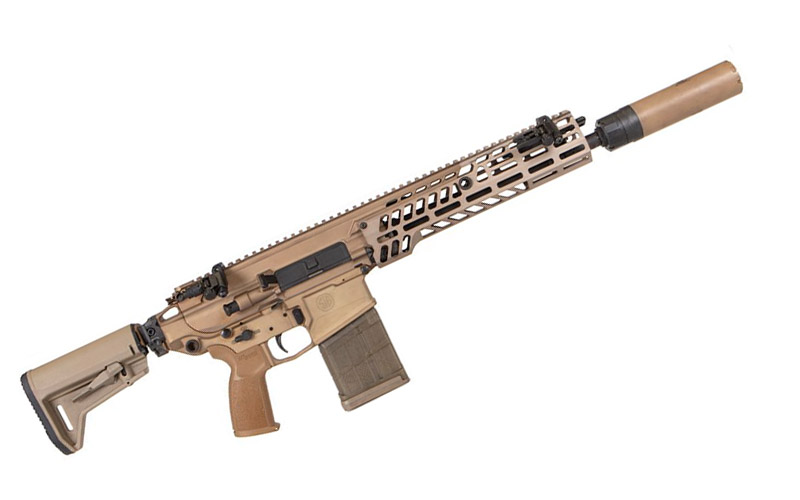
At present, no other rifle manufacturers are producing guns chambered in .277 Fury. Part of the reason could be gunmakers are waiting to see if the caliber catches on with the public. Another reason could be the nature of the cartridge itself.
Making a .277 Fury rifle is not just a simple matter of swapping barrels in an action. The pressure generated by the round means a trip back to the drawing board to beef up receiver designs or completely rework a gun. That’s a significant expense for a cartridge that is yet to prove its mainstream appeal. For companies that aren’t SIG, wait-and-see just might be the best strategy.
Niche Cartridge?
Does the introduction of the .277 Fury mean that 5.56 and 7.62 are going to be shelved? Hardly. The military will continue to use both for a long time as they work on integrating the new weapons and ammunition, and civilian shooters are too invested at this point to give either cartridge up. The future of .277 Fury with the civilian population will likely continue to increase as well, particularly if more ammunition manufacturers load the round and more rifles are chambered for it.
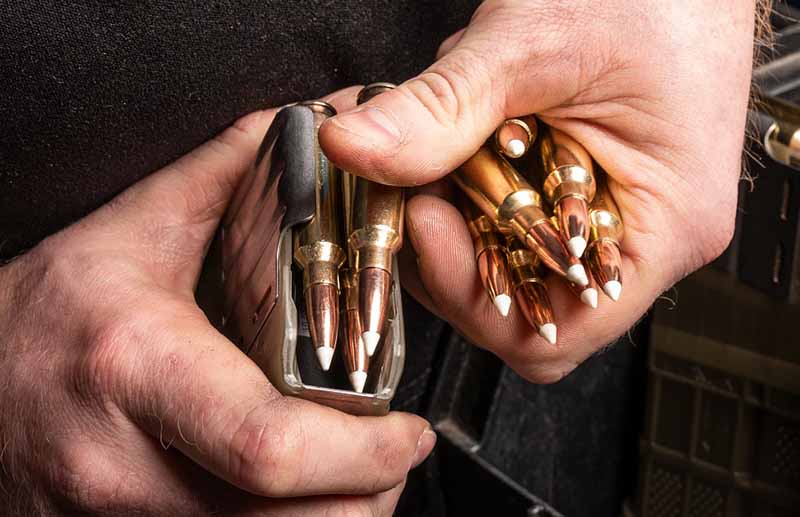
The Fury has both long-range competition shooting and hunting applications, but both areas have numerous rivals when it comes to performance and availability. However, the edge the .277 Fury has is huge—U.S. Military approval and backing. Nearly every caliber used by the military eventually becomes popular with civilians, and with time, this may prove true for the .277 Fury, too.
Editor's Note: This article has been updated to more precisely express the percentage difference of muzzle energy between cartridges.
More NGSW Stuff:
- Sig Sauer Announced As Winner Of NGSW Program
- Sig Sauer Launches Commercial Variant Of NGSW MCX-Spear
- The Sig SLX and SLH Suppressor Series
- First Look: True Velocity Composite-Cased Ammo
- True Velocity Composite-Cased Ammo Box Set

Next Step: Get your FREE Printable Target Pack
Enhance your shooting precision with our 62 MOA Targets, perfect for rifles and handguns. Crafted in collaboration with Storm Tactical for accuracy and versatility.
Subscribe to the Gun Digest email newsletter and get your downloadable target pack sent straight to your inbox. Stay updated with the latest firearms info in the industry.

![Best Concealed Carry Guns In 2025 [Field Tested] Wilson Combat EDC X9S 1](https://gundigest.com/wp-content/uploads/Wilson-Combat-EDC-X9S-1-324x160.jpg)


![Best 9mm Carbine: Affordable PCCs [Tested] Ruger Carbine Shooting](https://gundigest.com/wp-content/uploads/Ruger-Carbine-Shooting-100x70.jpg)
![Best AR-15: Top Options Available Today [Field Tested] Harrington and Richardson PSA XM177E2 feature](https://gundigest.com/wp-content/uploads/Harrington-and-Richardson-PSA-XM177E2-feature-100x70.jpg)

This cartridge and the AR.308 footprint platform are a step back and a ridiculously overpriced boondoggle. They could have simply switched to 6ARC or 6.5 Grendel uppers for longer range work and .400 Legend uppers for short range work to have at least 25rds double stacked in a standard AR15 form factor. That would be more than enough to take out the ChiComs and USSR and their 5.45×39, 9×39 and 5.8×42. Ammo would have tons of energy, great penetration, work great subsonic, shoot flat and far. The weapon conversion and ammo would be economical, the ammo and mags compact and light, if BCG durability with 6ARC or 6.5 Grendel is a concern using the same 6.8SPC case head as .400 Legend with a rebated rim for the 6ARC or 6.5 Grendel would be even better because only a barreled upper change using the same BCG and possibly different magazine is all it would take to go from the short 10-16″ barrel QCB .400 Legend to a long barrel 16-24″ 6ARC or 6.5 Grendel for higher velocity, flat shooting, long range, armor piercing weapon role. If steel cases and higher pressures were used for special loads like the 6.8×51 the performance would just as impressive and within the AR15 form factor. I think that the individuals responsible for the Sig deal need to be investigated for corruption, expecting the tax payer to spend $3000-5000 a rifle and $1.75-$4 a shot, especially considering what a scam the M17 Sig P320 gas been and how inferior of a choice it is to the Glock 19X that rightfully beat it and is preferred by everyone I have ever met or spoken to about the two and based on my experience with the two. The Glock is universal and is common sense just like a ln upgraded AR15 based weapons system with a larger caliber more powerful cartridge.
Just the idea of 80,000 psi in a chamber could change the shooting industry! A 223 with a 65 grain bullet at 80,000 would really tighten up groups at 500 yds!
For the love of God. Kill me.
80K PSI. Seriously.
Doesn’t matter anyway.
We don’t lose future wars because we don’t use tried tested and true.
We lose wars because we let the woke into our military ranks.
Right on!
A crappy pre-WW round doesn’t have the performance of modern bullets. Your backwards pre-Cold War thinking is why the west loses wars.
At 80,000 PSI, the Army’s adoption of this cartridge looks like a mistake. Not only will the specialized case be more expensive to manufacture, more expensive to buy, the rifle that must contain that extra 20,000 PSI will cost even more than a typical M4 or even a standard M16A3.
NATO won’t adopt it & neither will most other Western countries armies. Why spend the money?
The Army abandoned the M14 & the 7.62X51 cartridge primarily because it was heavy & over-powered needlessly in Viet Nam, plus soldiers could carry much more 5.56 ammo with their M16’s than 7.62.
Want a 6.8/.277 cartridge that is ALREADY PROVEN? The .270 will do almost everything the .277 Fury will do, cheaper.
quote——-This is the target load, and it uses a 135-grain FMJ bullet with a 0.475 BC. Factory data states that muzzle velocity from a 16-inch barrel is 2,750 fps and 3,000 fps from a 24-inch barrel. This round is specifically designed for long-range shooting. Expect to pay about $1.70 per round for this option, as 20-round boxes have an MSRP of about $34. ——–quote
Ho Hum my old fashioned .270 Winchester M70 produces 3,120 fps with the 130 grain bullet out of only a 22 inch barrel and the cartridge dates from the 1920’s. The sporting bolt action guns are way cheaper and so is the ammo. Isn’t the new latest and greatest Sig cartridge just reinventing the wheel if we are talking about a hunting cartridge?